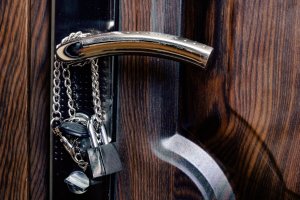
The best thing you can do in an active shooting emergency is get away from the scene. However, in some circumstances, leaving isn’t an option. If this happens, one way to protect yourself is to create a strong barricade.
Events unfold quickly during emergency situations. Hiding in a room and just locking the door may not be enough to separate yourself from the perpetrator. To strengthen your protection and increase your chance of survival, barricade the door to make it more yourself completely from the shooter.
Things you can Use to Barricade a Door
- Power cord
- Belt
- Necktie
- Doorstop or improvised door stop such as cardboard or piece of clothing
- Desk
- Table
- Chair
- Shelf, vanity, couch, cabinet, or any other heavy furniture
How to Barricade According to Door Types?
There are many different types of doors. Doors may vary in which direction they open, what materials they’re made of, how light can transmit through them, how much they weigh and how thick they are. So before anything happens, look around your space and familiarize yourself with the kind of doors that are around.
Inward Opening
Pros:
- Easy to barricade
- Can’t be pried into
- Needs to be pushed into the room to open
- Hinges aren’t visible and accessible from the outside
Cons:
- Can be kicked in or pushed open if barricade is not strong enough
Methods:
- Place heavy objects in front of the door so it won’t be pushed open from the outside.
- Place a chair at an angle under the door handle or lever (take note, not knob) to prevent the handle or lever from being turned to open.
- If there is a door stopper around or anything that can be utilized as one such as thick cardboard or socks, place it under the door to prevent it from opening.
Outward Opening
Pros:
- Difficult to pull open by intruders if properly secured
Cons:
- Challenging to secure
Methods:
- Use a cord, purse strap, belt, rope, or whatever you can find to use as a strong tool for tying, to tie around the handle or knob. Tie the other end around a heavy piece of furniture or sturdy post or pole to prevent the door from being pulled open from the outside.
- Block the opening with tall items. This may not prevent the door from opening but it will obstruct direct view into the room and could still serve as a barricade.
Sliding Doors
Pros:
- If the perpetrator isn’t familiar, they may not figure out that the door needs to be slid to the side to open
Easy to barricade
Cons:
- Usually made of light materials so easier to break through
Methods:
- Simply placing an object to stop the door from sliding through its frame could prevent it from opening. Sliding doors do not slide easily when their track is obstructed or they aren’t perfectly aligned to the frame.
- Place tall and heavy objects in front of the sliding door to prevent it from being knocked over from the outside, to obstruct view, and to serve as another layer of protection between you and the shooter.
Double Doors
Pros:
- Easy to barricade whether it swings inward or outward
Cons:
- Usually made of glass i.e. French door or has windows
Methods:
- Use anything to tie both knobs or handles on both sides of the door.
- Place tall and heavy objects in front the door to prevent entry or obstruct view from outside.
Aftermarket Locking Devices
Pros:
- Quick and easy to install
- Does an outstanding job of securing doors
Cons:
- Shooter could lock himself inside
- Fire hazard
- Could delay law enforcement or rescue’s entry
Methods:
- Depending on which way the door opens, use the same methods as inward opening doors or outward opening doors.
Keep in Mind
In the event there is an intruder and you are able to lock and barricade the door, there are a few additional ways to keep yourself safe. Here are a few basics to remember:
- Do not stand close to the doors or windows
- Block visibility from outside by closing curtains, blinds, or other objects to obstruct view
- Turn off lights
- Don’t use flashlights, phones, and other light-emitting devices inside the room
- Turn off radios, computers, and turn phones in silent mode
- Take cover behind concrete walls, thick desks or cabinets
Types of doors vary widely, just as building layouts, locations, and circumstances do. To learn the best ways to respond to an active shooting emergency, take IAHB’s personalized Surviving Active Violence and Emergencies group classes. These trainings are tailored according to your office, place of worship, school, restaurant, store, or community’s unique characteristics. Contact us at https://inaheartbeatllc.com/contact/ to learn more.